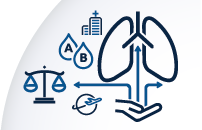Audience
- Lung transplant programs:
- TX Physician Assistants, TX Physicians-Additional, TX Physicians-Other, TX Program – Clinical Coordinators, TX Program Administrators/Managers
- TX Program Directors, TX Programs Chiefs, TX Surgeons-Additional, TX Surgeons-Other, Data Coordinators, Quality Coordinators, Quality Directors/Managers, Primary Data Coordinators, Primary Physicians, Primary Program Administrators, Primary Surgeons, Primary Surgeons 2
- OPTN Lung Transplantation Committee
- Heart-lung transplant programs
- OPTN Representatives and Alternate representatives
Implementation date
Nov. 8, 2022
At-a-glance
Two new fields are now in effect for lung data collection in preparation for lung continuous distribution, which is to be released in the first quarter of 2023.
The two new fields include:
- Prior living donor
- Requires documentation to be submitted to the Organ Center for lung candidates who previously donated an organ in order for those candidates to receive prior living donor points.
- On high flow nasal cannula
- Displays when the candidate requires supplemental oxygen at rest, at night or with exercise.
- This field will become required for all lung candidates receiving supplemental oxygen at rest, at night or with exercise when lung continuous distribution is implemented in early 2023.
A new report in WaitlistSM titled the Lung Composite Allocation Score: 28 day report has been created to help support members in their compliance with OPTN Policy 10.3. A Lung Clinical Values That Must Be Updated Every 28 Days.
The report will also include a transition report section to assist you in identifying candidates that are missing a response for the new question regarding supplemental oxygen delivery via a high-flow nasal cannula.
What you need to do
Transplant hospitals
For each candidate that requires supplemental oxygen at rest, with exercise or at night:
- Update the candidate record to indicate whether the oxygen is delivered via a high flow nasal cannula. A transition report is available in Waitlist to help you identify candidates that require a response to the question “On high flow nasal cannula?” but this data collection is not required until implementation of continuous distribution of lungs.
- Upon implementation of continuous distribution of lungs, utilize the new Lung Composite Allocation Score: 28 day report in Waitlist to monitor and update clinical values for candidates meeting the frequent reporting criteria.
If your candidate has donated an organ for transplantation within the U.S. or its territories, they are eligible for additional points under lung continuous distribution allocation. The candidate’s physician will need to:
- Report all of the following information to the OPTN using the form available in UNetSM Resources, Forms/Tools
- a) the name of the recipient or intended recipient of the donated organ or organ segment,
- b) the recipient’s or intended recipient’s transplant hospital, and
- c) the date the donated organ was procured.
Additional details
This data collection is in preparation for the implementation of lung continuous distribution in the first quarter of 2023. There is no impact to the candidate’s lung allocation score (LAS) at this time.
Reporting prior living donor status prior to implementation of allocation changes will allow your candidate to receive five attribute points in the Patient Access goal on implementation day of lung continuous distribution.
Candidates on continuous mechanical ventilation, ECMO or receiving supplemental oxygen via a high flow nasal cannula will meet the criteria outlined in the approved OPTN Policy 10.3.A. When a candidate meets the criteria, the values for supplemental oxygen and assisted ventilation must be updated every 28 days. If the values are not updated on the 28 day interval, the policy default values specified in OPTN policy will be used in the calculation of the candidate’s lung composite allocation score (CAS).
High flow nasal cannula is defined as an oxygen supply system capable of delivering up to 100% humidified and heated oxygen at a flow rate of up to 60 liters per minute.
Education and resources
For further details and resources, please visit the implementation toolkit on the OPTN.
Professional education on this policy change is available in the OPTN learning management system known as UNOS Connect:
- Lung Continuous Distribution Playlist
- LUN102 Basic Principles of Lung Continuous Distribution
- LUN103 Unacceptable Antigens & CPRA in Lung Continuous Distribution
- LUN104 Scoring and Exceptions Under Lung Continuous Distribution
- SYS183 Using the Lung CAS Report (see below reference to access report)
- LUN105 Preparing for Implementation of Lung Continuous Distribution
Lung transplant programs can access a program-specific composite allocation score (CAS) resource report in the Data Services Portal within UNet. Please access the Lung CAS Report for your transplant program in the OPTN Data Files section in the Data Portal.
To view your program’s candidate report in a national perspective, a set of CAS summary reference statistics are also available on the UNOS website.
Questions?
If you have questions relating to implementation, contact UNOS Customer Service at [email protected], or call 800-978-4334 from 8 am to 7 pm EST.
For policy-related questions, contact [email protected]
Lung continuous distribution
New lung policy took effect March 9, 2023. Resources: UNOS Connect for professional education and the OPTN toolkit for patients and professionals.

